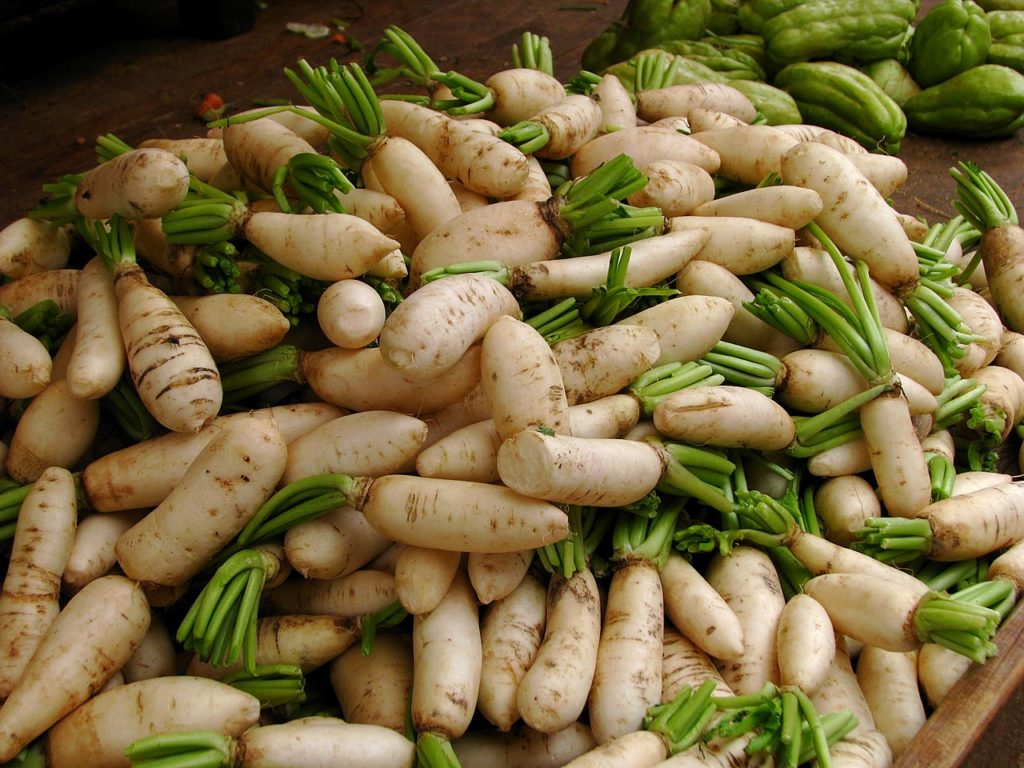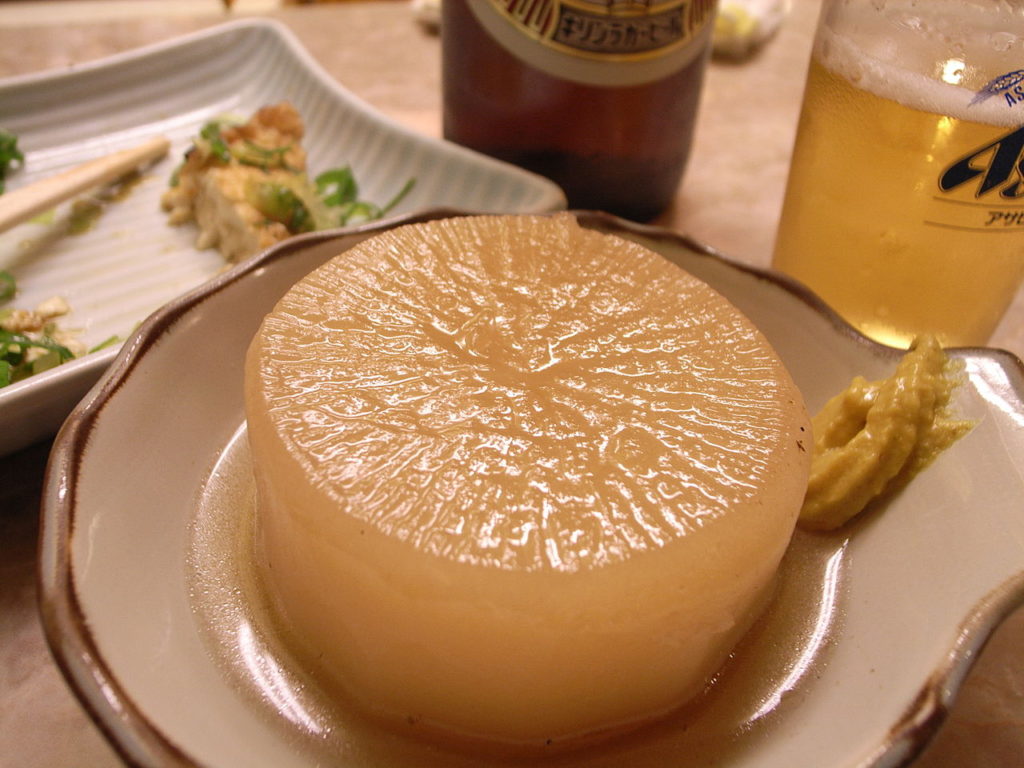
grapplingstars.com, femcompetitor.com, fciwomenswrestling.com, fcielitecompetitor.com fciwomenswrestling2.com articles, pexels.com pixabay.com photo
August 12, 2020,
In a quest to continue healthy eating and living, the search for the unknown food that can help improve both is never ending.
Sometimes it is a food that is over looked but so healthy for your body.
How many times have you eaten daikon?
Daikon is a mild-flavored winter radish usually characterized by fast-growing leaves and a long, white, napiform root. Originally native to Southeast or continental East Asia, daikon is harvested and consumed throughout the region, as well as in South Asia, and is now available internationally.

We’re certainly glad of that.
In North America, it is primarily grown not for food, but as a fallow crop, with the roots left unharvested to prevent soil compaction and the leaves (if harvested) used as animal fodder.
The official general name used by the United States Department of Agriculture is oilseed radish, but this is only used in non-culinary contexts. Other English terms employed when daikon is being used as animal feed or as a soil ripper are forage radish, fodder radish, and tillage radish.
In Japan, many types of pickles are made with daikon, including takuan and bettarazuke.

The generic terms white radish, winter radish, Oriental radish, long white radish, and other terms are also used to describe daikon.
Daikon is also frequently used grated and mixed into ponzu, a soy sauce and citrus juice condiment. Simmered dishes are also popular such as oden.
Daikon that has been shredded and dried (a common method of preserving food in Japan) is called kiriboshi-daikon (literally, “cut-dried daikon”). Daikon radish sprouts (kaiware-daikon) are used for salad or garnishing sashimi.
Daikon leaf is frequently eaten as a green vegetable. Pickling and stir frying are common. The daikon leaf is part of the Festival of Seven Herbs, called suzushiro.
Very educational.
We have a friend in our circle who has her own personal story with this powerful radish.
She developed strong digestive issues and lost about thirty pounds in 3 months and was afraid that she was going to die.
She tried all of the traditional medicines, which didn’t work and had side effects, then she tried acupuncture.
Bingo.
That at least opened the door for her to slowly start eating again.
She also began to research foods that helped in digestion and assisted in providing good bacteria while getting rid of the bad ones.
Based upon her research she finally came across daikon.
“When I prayed for success, I forgot to ask for sound sleep and good digestion.”… Mason Cooley
She had a friend who was exceptional at Japanese cooking who used to provide daikon as a side dish but she never understood how powerful this radish could be.
The team at lifegate.com educate, “Daikon has many unbelievable therapeutic virtues and it is rich in nutrients. It is high in minerals including calcium, potassium, magnesium, iron, phosphorus, vitamin C, vitamins of group B and fibres, it has fat-burning properties because it metabolises them.
This is not by chance that in Japan it is served with tempura or fried foods. It has detoxifying, anti-swelling, diuretic and cleansing virtues and it is recommendable for those who suffer from water retention and cellulite. It relieves congestions, so, it is useful if you have the cough or cold.”
Those are quite a few substantial benefits.
What our friend really focused in on was daikon’s digestive value. It really helped with her digestion and helped her on the road to at least partial recovery.

Even partial in her case was huge.
Her thinking is supported by the information found at livestrong.com who add, “The “Dietary Guidelines for Americans, 2010” reports that most Americans only consume about 15 grams of fiber daily, which is far short of the recommended intake. If you need to boost your fiber intake, add daikon to the menu. You’ll get 2 grams of fiber from 1 cup of sliced daikon radish. Getting the recommended amount of fiber — 25 grams daily for women and 38 grams for men — reduces your risk of developing cardiovascular disease because soluble fiber helps lower cholesterol. It also prevents spikes in blood sugar and provides roughage, which keeps your digestive tract regular.”
Our friend was happy she could measure the difference.
The amazing radish has more than dietary benefits. At outsidepride.com, a company that specializes in keeping your outdoor property beautiful has this to say about the daikon, “Fracking Daikon Radish is a deep rooted forage radish that will make an outstanding winter cover crop.
The deep taproot of the large rooted plant can help break up the tough, compacted soil, improve water infiltration, suppresses weeds, eliminate pests and stores nitrogen. When planting daikon radish seed as a cover crop, the benefits will be optimized if planted in late summer:
- Reduces soil compaction
- High Biomass production
- Increases water infiltration
- Excellent erosion control
- Great weed suppression
- Fast establishment
That is not near all there is to know about Daikon radish. Some people refer to it as Oriental radish, but daikon is a vegetable that actually goes by many names including: mooli, Chinese radish, Satsuma radish and Japanese radish. In fact, daikon in Japanese means “big root.” It is grown around the world, but primarily here in the U.S. daikon radish seeds are planted as a cover crop to prevent soil compaction, which then allows soil to absorb more rainfall.
You can tell Daikon apart from other radishes by its appearance: it has large, fast growing leaves and a long white root which looks similar to a pale carrot. Daikon can grow up to 20 inches long with a diameter of 4 inches. As far as flavor, it is considered milder and less peppery than other radishes. If you prefer to eat it raw, then it will have a mild and tangy taste with a crisp and juicy texture. If you prefer to cook it, it tastes similar to turnips.”
We’ve had daikon ourselves and can attest to its tasty value especially when you have it with fairly starchy foods like noodles, spaghetti and potatoes. Our dressing of choice to enhance daikon with is Italian.
Zesty and tasty.
So we won’t say search no more for super foods that can enhance both your fitness and digestive health but daikon makes us at want to say that.
We suggest that you keep searching and do your research.
Coming across daikon was a special upgrade for us.
With its myriad of uses, daikon might be just right for your table too.
It sure puts a smile upon our face.

~ ~ ~
OPENING PHOTO grapplingstars.com, femcompetitor.com, fciwomenswrestling.com, fcielitecompetitor.com fciwomenswrestling2.com articles, pexels.com pixabay.com photo
https://en.wikipedia.org/wiki/Daikon
https://www.lifegate.com/people/lifestyle/daikon-radish
https://www.livestrong.com/article/525713-the-nutrition-in-daikon/
https://www.brainyquote.com/topics/digestion-quotes
https://fciwomenswrestling.com/
https://www.fcielitecompetitor.com/



